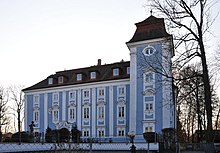Lichtenegg moated castle


The former moated castle Lichtenegg (sometimes also written Lichteneck ) is located in the city of Wels in Upper Austria in the Lichtenegg district .
history
Lichtenegg Castle dates from the 16th century and was originally a moated castle . It was built by Ludwig von Polheim . At that time the castle included a dairy farm , gardens, a pond, a copper hammer and a brass foundry . Of Emperor Maximilian II. It was elevated to a free estate and aristocratic seat. In 1613 Job Hartmann Ennenkl zu Albrechtsberg bought the castle. The property passed to Christoph Ehrenreich von Schallenberg as the marriage property of Judith Elisabeth Freiin von Ennenkel . Again, Lichtenberg came to Count Hanns Siegmund Kazianer as the marriage property of Count Schallenberg's daughter Christina Dorotheas . On the Kaufweg, the property passed to the pastor and dean of Gmunden, Johann Josef Ehrenreich, Count of Seeau. In 1654 the castle came into the possession of the princes of Auersperg . In 1722 he sold it to Count Georg Josef von Mannstorf. Lichtenegg came to Josef Pilati von Tassul through Maria Theresa Freiin von Mannstorf, the last of her name . The Pilati remained in the possession of Lichtenegg until 1850, from this family the rulership of Lichteneck held: Johann Baptist Freiherr and later Count von Pilati and Tassul, kk chamberlain, councilor, court counselor and knight of the St. Stephen's Order and Count Karl von Pilati, first kk District Commissioner for Wels and District Chief for Ried. Then it was acquired by Franz Seraph Ritter von Erb (until 1859). This was followed by a rapid change of ownership, e.g. B. Freiherr Herrmann and Richard Daublebsky von Sterneck (1868-1883), Ludwig Hinterschweiger, Theresia Wieser and Leopoldine Egsen, also the Duchy of Braunschweig (most recently Prince Christian of Hanover, born September 1, 1919, † December 10, 1981) was the owner. In the autumn of 1890, Archduke Franz Salvator of Austria-Tuscany and the imperial daughter Marie Valerie leased Lichtenegg Castle and lived there until 1897.
Lichtenegg Castle then and now
The extensive grounds of Lichtenegg are shown in an engraving by Georg Matthäus Vischer from 1674. At that time the main building was in a pond and could only be reached via a wooden bridge. A porch, reinforced with two side towers and also accessible via a bridge, lay behind a moat. Outside the actual castle grounds there was another forecourt protected by walls and gate entrances; the buildings of a meierhof and an administration building can be seen here .
Today the moat has completely disappeared. The appearance of the castle is shaped by the renovation by the Wels master builder Wolfgang Grinzenberger in 1726 and by adaptation work towards the end of the 19th century. After bomb damage in World War II , the castle was restored in 1952 and 1953.
The castle and the accompanying English park were renovated in 1986. Today, two square towers flank the three-story, square complex on the entrance and park side. In the park there are sandstone figures from the 17th century, which was then a French rococo garden . Today there are apartments in the castle.
literature
- Norbert Grabherr : Castles and palaces in Upper Austria. A guide for castle hikers and friends of home. 3rd edition . Oberösterreichischer Landesverlag, Linz 1976, ISBN 3-85214-157-5 .
- Georg Grüll : Castles and palaces in the Salzkammergut and the Alps . Birken-Verlag, Vienna 1963.
- Oskar Hille: Castles and palaces in Upper Austria then and now . Verlag Ferdinand Berger & Sons, Horn 1975, ISBN 3-85028-023-3 .
Individual evidence
Web links
- Entry via moated castle Lichtenegg on Burgen-Austria
- Konrad Meindl: History of the city of Wels in Upper Austria OÖLB , 1878, p. 130.
- Lichtenegg Castle on Oberösterreich.at
- Video Historic Wels Episode 13: Lichtenegg Castle
Coordinates: 48 ° 9 ′ 6.7 ″ N , 14 ° 0 ′ 20.4 ″ E

